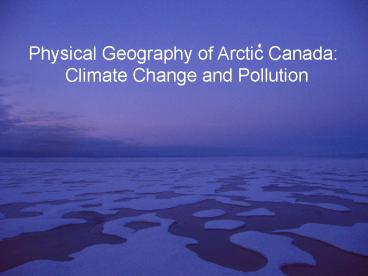Physical Geography of Arctic Canada: - PowerPoint PPT Presentation
1 / 15
Title:
Physical Geography of Arctic Canada:
Description:
Arctic Ocean watershed. Contamination Pathways ... Volcanic rock kimberlite pass through the cratonic rock in magma during volcanic ... – PowerPoint PPT presentation
Number of Views:114
Avg rating:3.0/5.0
Title: Physical Geography of Arctic Canada:
1
Physical Geography of Arctic Canada Climate
Change and Pollution
2
How do pollutants reach Arctic Canada?
Contamination Pathways
Arctic Ocean watershed
Mercury levels in the blood of indigenous women
of reproductive age
PCBs in the blood of Arctic peoples
3
Arctic food web The biomagnification of
pollutants
Murres migrate 1000s of miles, and bring
contaminants with them.
Inuit woman preparing Country Foods
4
Diamond mining in the Arctic Canada
- Diamonds form in extremely high pressure and
temperature. These conditions are only possibe
very deep in the Earths crust or upper mantle - Volcanic rock kimberlite pass through the
cratonic rock in magma during volcanic eruptions.
These veins act as carriers of diamonds and other
rock fragments.
5
Diamond mines in the Northwest Territories
- Two operaiting mines Ekati and Diavik
- Two other diamond projects Jericho and Snap Lake
- Impacts caused by mining
- blasting, dangerous excavations and shafts,
movements of heavy equipments, dust and gases in
underground workings - Key to mitigating environmental risks is setting
and monitoring appropriate standards. Focus on
six areas - land and water use
- waste management
- chemicals and pollutants
- tailings disposal
- human health risks and
- potential environmental risks and the plans to
mitigate these risks
6
Methane Production and Effects
- Methane is a greenhouse gas produced by many
different processes including the breakdown of
organic material in anoxic environments,
livestock, and organic activity from flooded rice
fields (to name a few) - It is a more potent greenhouse gas than CO2
- The warming of the arctic is introducing more
methane into the atmosphere - Arctic warming is reducing the extent of
permafrost in the arctic and changing continuous
to discontinuous - Melting permafrost and an increasing depth of
the active layer produces waterlogged soils and
exposes the built up organic material to
anaerobic processes which release methane
7
Feedback Loop
- Methane in the atmosphere traps solar radiation
in the atmosphere - By reflecting the wavelengths emitted by the
earth back down to the surface it adds additional
energy to the surface, increasing the temperature - This increase in temperature drives the melting
of permafrost, and other changes in the biotic
and abiotic arctic environment - The warming temperatures and melting permafrost
provide an anoxic environment for methane
production - Methane is then released and moves up into the
atmosphere compounding the problem further by
trapping more solar radiation at the surface and
increasing warming
8
Arctic Oscillation
- Positive Phase
- Prevailing low pressure over North Pole
- Strong Westerlies
- Warmer Winters for Northern Hemisphere
- Negative Phase
- Higher than normal pressure over North
Pole - Weak Westerlies
- Colder winters for Northern Hemisphere
9
Responsible for global warming?
- General increase in both trends from 1960-1992
- During 1990s, Arctic Oscillation index levels
off while global temperature continues to rise - Arctic Oscillation and broader global warming
trend not strongly correlated
10
Sea Ice Depletion
Mean deviation from average area.
11
Importance
- Climate control
- Albedo
- Ocean circulation
- First indicator for global warming
12
Repercussions of Sea Ice Depletion on Global
Climate
Hypothesis Thermohaline circulation will shut
down temporarily or permanently depending on the
continued rate of warming.
13
Thermohaline Circulation
- Great Ocean Conveyor Belt
- Is caused by temperature and density differences.
- Freshwater is evaporated or frozen into pack-ice,
increasing the salinity of the remaining ocean
water. - Increasing Arctic temperatures decrease North
Atlantic water density by adding more freshwater
through melting pack ice and glaciers. Also,
less freshwater is removed in first place by
pack-ice formation.
14
What Could Happen?
- Image shows projected cooling caused by shut down
of the thermohaline circulation in the North
Atlantic. Maximum cooling of -6C, -8C is
centered around Greenland, eastern Canadian
Arctic region, and Scandinavia.
15
Conclusion
- Pollution and climate change have the potential
of severely changing the Arctic environment. - It is important to understand the environmental
systems of the Arctic in order to predict future
changes. - Please recycle and dont drive.































